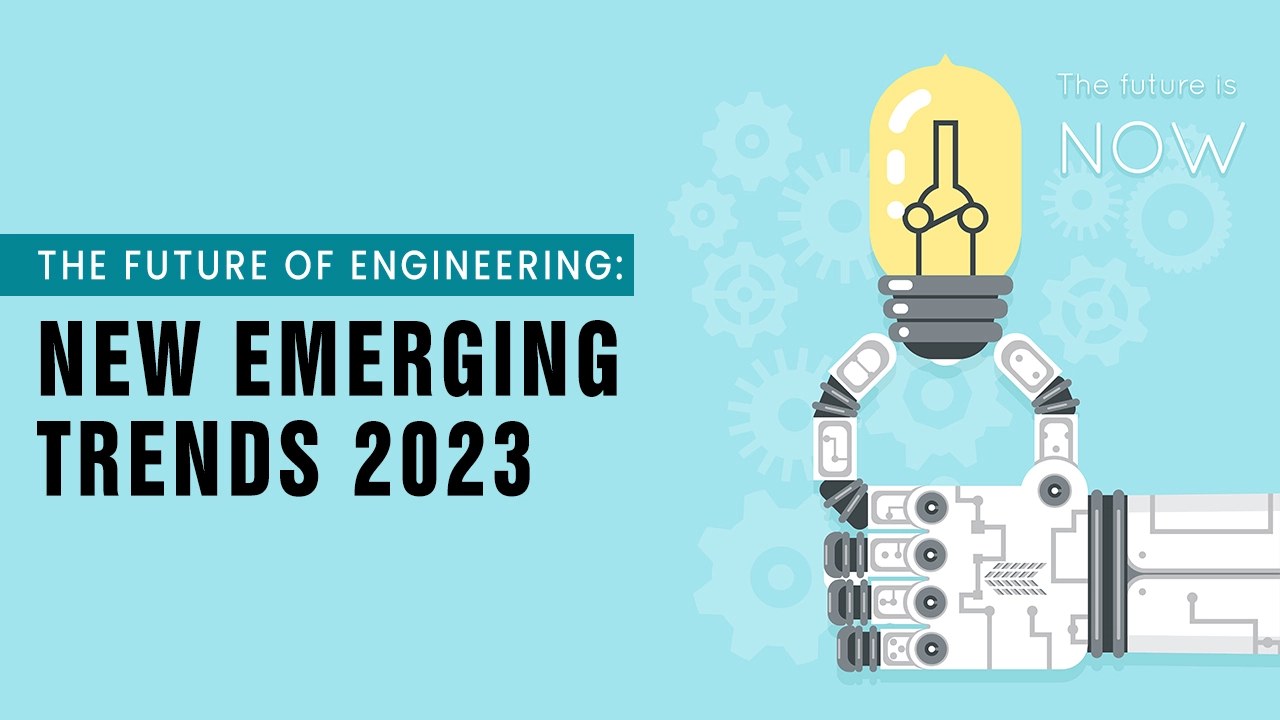
The Future of Engineering: New Emerging Trends 2023
What is the future of engineering? And how does it lead the human development? As time changes, engineering modifies and develops itself to meet the new-age demands. As a result of the ground-breaking innovation and breakneck advancement in technology. Furthermore making it a field of vast and high-paying career opportunities.
Engineering is a field that uses the knowledge and applications of science and mathematics to solve complex day-to-day problems. The are several engineering disciplines you probably have heard about such as mechanical engineering, software engineering, robotics, data science, civil engineering, biomedical engineering etc.
Most Popular Engineering Trends of 2023
Below are the new-age engineering trends that are shaping the future of engineering as well as the growing development of human civilization.
AI & ML (Artificial Intelligence and Machine learning)
The whole world is witnessing a shift towards Artificial Intelligence and Machine learning because it accelerated the growth of businesses from every aspect. Being adopted by Autonomous Vehicles, E-commerce websites & applications, the Healthcare Industry, the Education Industry etc. Furthermore, aiding in creating Spam filters, online customer support, voice assistants, chatboxes and more advanced convenient features.
Automation
Automation is the process to build smart machines to minimize the overall human inputs with fewer safety risks. Automation allows engineers to increase production processes and simultaneously get projects done on time and cost-effectively with lesser human errors. There are three types of automation:
- Basic Automation
- Process Automation
- Intelligent Automation
Cybersecurity
With the internet connecting places to places, the problems of security breaches are increasing exponentially. So now, Cybersecurity comes into play which is the process of building information security walls to protect private information, infrastructure, applications etc from malware or cyber-attacks. Fundamentally, there are three types of Cyber security:
- Network Security
- Cloud Security
- Physical Security
Big Data
Big data refers to the vast amount of structured, semi-structured, and unstructured data that is generated and processed every day. The analysis of big data provides valuable insights into various areas such as customer behaviour, market trends, operational efficiencies, and scientific discoveries. To process and analyze big data, specialized tools and techniques such as distributed computing, machine learning, and artificial intelligence are often used. It is characterized by its volume, velocity, variety and veracity.
- The volume of big data is enormous and is growing at an unprecedented rate, with terabytes and petabytes of data being generated every day.
- Velocity refers to the speed at which data is generated, processed, and analyzed, which is often in real-time or near-real-time.
- Variety refers to the different types of data that are generated, such as text, images, videos, audio, and sensor data, among others.
- Veracity refers to the accuracy, consistency, and reliability of the data.
EV (Electric Vehicles)
Electric vehicles are another future of engineering that is becoming increasingly popular due to their lower operating costs, improved environmental performance, and the development of charging infrastructure. Many countries and cities around the world are implementing policies to encourage the adoption of electric vehicles as part of efforts to reduce greenhouse gas emissions and combat climate change.
Electric vehicles are vehicles that are powered by electric motors instead of internal combustion engines (ICEs) that run on gasoline or diesel. They use electricity stored in rechargeable batteries to power the electric motor that drives the wheels. There are two main types of Electric Vehicles:
- Battery Electric Vehicles (BEVs)
- Plug-in Hybrid Electric Vehicles (PHEVs)
Augmented Reality
Augmented reality (AR) is a technology that enhances the real-world environment by overlaying digital information, such as images, sounds, and 3D objects, onto it. Augmented Reality is typically experienced through a device such as a smartphone or a tablet, which uses its camera and sensors to track the user’s location and orientation in real time and superimpose the digital content onto the view of the physical world. It is used in a variety of applications, including gaming, education, entertainment, retail, and manufacturing.
AR technology is rapidly advancing, and it has the potential to revolutionize the way we interact with the world around us. With the development of wearable AR devices such as smart glasses, AR is expected to become even more integrated into our daily lives, enabling us to access information and interact with digital content seamlessly and effortlessly.
Renewable Energy
Renewable energy is energy that comes from natural sources, which are naturally replenished and do not deplete over time. These sources include sunlight, wind, rain, geothermal heat, and biomass. Renewable energy is often referred to as clean energy because it produces little to no greenhouse gas emissions or pollutants.
There are several types of renewable energy technologies.
- Solar energy is generated by capturing the energy from the sun using solar panels or mirrors.
- Wind energy is produced by wind turbines that convert the kinetic energy of wind into electrical power.
- Hydropower uses the kinetic energy of flowing water to generate electricity.
- Geothermal energy harnesses the heat from the earth’s core to generate electricity or heat buildings.
- Biomass energy is generated by burning organic matter such as wood, crop waste, or municipal solid waste to produce heat or electricity.
It is sustainable, reduces dependence on imported energy, creates jobs, and can provide affordable energy to underserved communities. Additionally, it can help to reduce greenhouse gas emissions and mitigate climate change.
Governments around the world are promoting the use of renewable energy by implementing policies that support renewable energy development, such as tax incentives, renewable energy targets, and feed-in tariffs. The use of renewable energy is expected to continue to grow as technology advances and the cost of renewable energy continues to decrease.
IoT (Internet Of Things)
The Internet of Things (IoT) is a network of physical devices, vehicles, appliances, and other items that are embedded with sensors, software, and connectivity, which enables them to connect and exchange data with each other and with the Internet. The data collected by these devices can be used to analyze and optimize performance, monitor and control operations, and provide real-time feedback and alerts.
IoT has the potential to transform the way we live and work by creating a more connected, efficient, and intelligent world. Some of the key benefits of IoT include improved efficiency, increased productivity, enhanced safety and security, and better decision-making.
3D Printing
3D printing, also known as additive manufacturing, is a technology that allows the creation of three-dimensional objects by adding layer upon layer of material. This is in contrast to traditional subtractive manufacturing processes, where the material is removed from a block of material to create the final object.
3D printing has a wide range of applications, including rapid prototyping, product development, and even the creation of customized medical implants and prosthetics. As 3D printing technology continues to advance, it is becoming more accessible and affordable for both individuals and businesses. The technology is expected to continue to transform manufacturing and enable new possibilities in fields such as healthcare, aerospace, and construction.
Quantum Computing
Quantum computing is a type of computing that uses the principles of quantum mechanics to perform calculations. Quantum computing has the potential to revolutionize computing by solving complex problems that are difficult or impossible for classical computers to solve. For example, quantum computers could be used to simulate complex chemical reactions, optimize logistics and transportation networks, or break complex encryption algorithms.
However, quantum computing is still a developing field, and there are many technical challenges that must be overcome before quantum computers can be used on a large scale to shape the future of engineering. These challenges include developing stable qubits, improving error correction techniques, and building a robust software ecosystem to support quantum applications.
Recent Post
